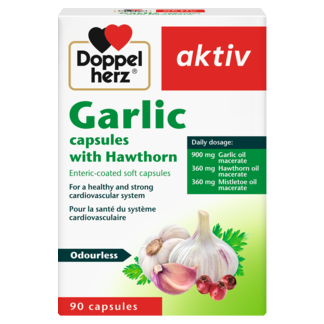Cardiovascular

Cardiovascular products

Support your heart and circulation
The heart has various ways of adapting its performance to the increased blood requirements during physical strain. We should protect and strengthen our cardiovascular system to enable it to accomplish this incredible performance.
Live with a healthy heart:
- Avoid stress
- Exercise regularly
- Fill your plate with freshness, variety and diversity
- Eat low-fat and low-salt foods
- Drink lots of water
- Avoid addictive drugs
- Get plenty of sleep
- Maintain normal weight
Good nutrition – not only for the heart
With a balanced and wholesome diet, you can make a big contribution to your general health and well-being. Don't worry, even a heart-healthy diet can be delicious and satisfying!
Simply put, the foods we choose to eat should be fresh, low-fat, mainly vegetable-based and adequate in terms of caloric intake.
Try to eat as much food with high vitamin and fiber content as possible, such as fruits and vegetables (e.g. raw-vegetable salads or potatoes). The recommended quantity is 3-5 helpings a day, or 400 grams.
Avoid fatty foods and frequent consumption of meat or meat products. If you do eat meat, it is best to choose light, lean meat or poultry. In your cooking you should prefer vegetable fats, such as olive or rapeseed oil, over animal fats. Vegetable oils are rich in valuable unsaturated fatty acids. A handful of nuts or seeds, by the way,
is also a good source of healthy fatty acids.
Sea fish are also important for a heart-healthy diet. They are another good source for the polyunsaturated omega-3 fatty acids EPA and DHA and contribute to a normal heart function. It is a good idea to have fish on the menu at least twice a week.
Are you an herb lover yet? Good, because with fresh herbs and spices, we save salt. Our eating habits, unfortunately, include an excessive amount of salt, which has an unfavorable impact on our blood pressure.
If, last but not least, you take care of your fluid balance, you have done a great deal for your health. 2-3 liters of water, tea or unsweetened juice/water mixes are preferable to sugar-rich and high-calorie fruit juices and soft drinks.
Garlic – helps prevent arteriosclerosis
Garlic (allium sativum) belongs to the Alliceae family (together with onions and leeks) and is known as a vegetable, spice and medicinal plant nearly all over the world.
The garlic plant has been used in traditional medicine for more than 5,000 years. Garlic was already used by the ancient Egyptians to maintain their good health and performance when building the pyramids.
To this day, garlic is highly appreciated for its valuable contribution to vascular health and is used to prevent general arteriosclerosis.
The international cuisine contains a wide variety of applications for fresh garlic:
- Whole cloves: For larding a roast.
- Fine slices: Raw or sweated for seasoning. Garlic is milder in taste if lightly sweated.
- Mush: Crushed garlic cloves are good to add to mashed potatoes and hearty soups.
- Juice: Fresh garlic juice is easily produced with a garlic press and a perfect additive to lots of dishes.
Attention: Do not overheat garlic because excessive temperatures destroy precious nutrients. Garlic should, therefore, be added just before the end of cooking.
The best-known substance in garlic, by the way, is a sulfurous amino acid: Alliin.
By peeling and mincing the clove of garlic, the ingredient alliin is converted into allicin. Allicin is also what gives garlic its typical smell and in nature serves the plant as a defense mechanism.
Doppelherz Garlic capsules with mistletoe and hawthorn. Application:
Traditional herbal medicine to prevent general arterial calcification (arteriosclerosis) exclusively based upon longstanding use.
Refer to the package leaflet for risks and side effects, and consult your doctor or pharmacist.
Hawthorn – for a powerful heart
The hawthorn of the rosaceae family is also a well known and proven medicinal plant. Other common names include may, mayblossom, maythorn, quickthorn, whitethorn, motherdie, and haw, and the berry-like fruits have a floury taste. The generic name Crataegus alludes to its firm wood (Greek krataios = firm, solid).
Its beneficial effects on the heart and blood circulation was appreciated already in the Middle Ages. Even today, hawthorn preparations are popular for cases of decreasing heart performance – especially in old age.
The active substances of hawthorn are contained in the red berries as well as in the leaves and blossoms. Dried quickly and under gentle conditions, they are rich in precious phytonutrients, such as flavonoids and procyanidins.
Hawthorn dragées. Active substance: Hawthorn leaves with blossom powder. Application: Traditional herbal medicine to support the cardiovascular function exclusively based upon longstanding use. Warning: Contains sucrose (sugar).
Refer to the package leaflet for risks and side effects, and consult your doctor or pharmacist.
